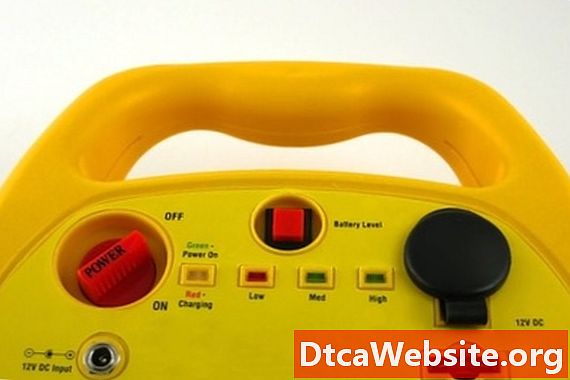
Contenu

The idea way to maintain a 12-volt lead-acid battery in good condition is to regularly discharge it by about 70 percent and then charge it up slowly. However, you know thats not a practical option as you need your car battery everyday and it gets a small discharge then gets recharged every time you use your car. Under normal circumstances you dont think about your 12-volt car battery from one month to the next; until you find its not taking a charge and goes dead. Before you decide to get a replacement, or simply put it on charge, have a go at rebuilding the cell structure of your lead-acid battery.
Step 1
Wear protective gloves and goggles before you rebuild the cell structure of your 12- volt battery. You need to access the cell reservoirs that contain highly toxic sulfuric acid that immediately burns on contact with skin.
Step 2
Place your 12-volt lead-acid battery in a battery tray on a stable work surface. Remove the six battery cell caps on top of the battery. Either unscrew the caps using your fingers, or if the caps have slots, use a screwdriver. Each cell produces 2 volts and is linked in series to produce 12 volts. Put the caps to one side.
Step 3
Check the fluid level inside the six cells. Its likely you find the fluid level is below the minimum mark on the inside of the cells. This means the process of the electrons flowing from one lead plate to the other inside the cell has stopped. The fluid, called electrolyte, is sulfuric acid and enables a chemical reaction to take place between the positive and negative plates when the battery gets a flow of electricity from the cars alternator or battery charger. If the fluid level drops below the minimum marker, the plates would be exposed, and they would corrode over time.
Step 4
Rebuild the chemical cell structure by replacing the fluid. Use distilled water and top each cell up to the maximum marker inside the cell. Its important that you dont overfill the cell as during the charging process the cells get warm and the fluid expands. The distilled water will mix with any existing sulfuric acid in the cell and start to rebuild the chemical structure. However, for the process to begin the battery needs electrons to flow between the plates created by a small electric current from a battery charger.
Step 5
Replace the cell caps using your fingers or a screwdriver. Dont over-tighten.
Step 6
Put the spring clamp on the end of the black battery charger cable onto the negative battery terminal. Its clearly labeled "Neg," "-" or may have a black plastic ring around the terminal pole. Put the spring clamp on the end of the red battery charger cable onto the other battery terminal. Its clearly labeled "Pos," "+" or may have a red plastic ring around the terminal pole.
Step 7
Set your battery on the lowest setting possible; often called "trickle charge." Rebuilding the chemical structure inside the cells takes time and its important the process is done slowly so the distilled water gets more acidic. As acidity increases so electron flow increases between the lead plates. Any corrosion on the plates caused by lack of electrolyte dissipates rebuilding the structure.
Step 8
Plug in your battery charger and turn it on. Check the setting again to make certain its on the lowest possible. Leave the 12-volt lead-acid battery to charge slowly for 36 hours. During this time, the energy retention of the plates increases as chemical activity changes. You can check if the rebuilding process is working by touching the side of the battery after about 12 hours. You would find its getting warm indicating that the battery is taking a charge.
Turn off the battery charger after about 36 hours. Disconnect the battery cable clamps from the battery terminals. Place your hand on the side of the 12-volt lead-acid battery, and you find its fairly warm to the touch meaning the chemical cell structure is rebuilt, and your battery has retained a charge.
Tip
- If you find the battery is cold, or only part of it is warm, after the charging period you probably have to resign yourself to buying a replacement as the plates in the cells were too corroded and couldnt rebuild.
Warning
- Only use distilled water to top up the battery cells. Regular tap water contained minerals and other impurities that prevent electron flow, reduce acidity and attach to the lead plates causing corrosion.
Items you will need
- Protective gloves
- Protective goggles
- Screwdriver
- Distilled water
- Battery charger


